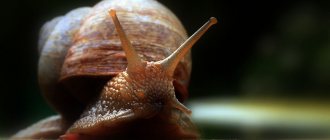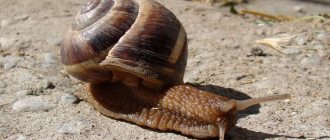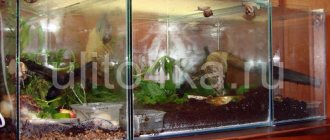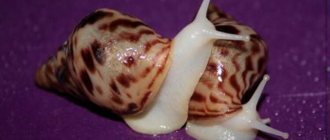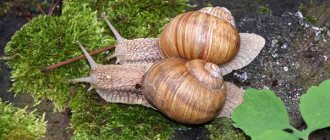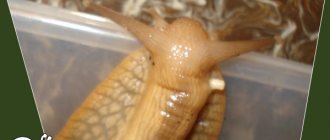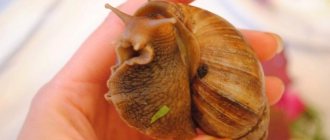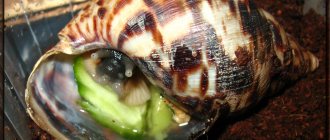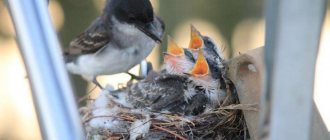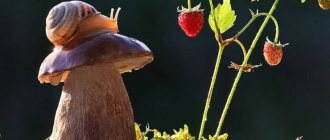Every pet, especially exotic pets, needs to be provided with conditions that are as close to natural as possible. And snails are no exception. Therefore, it is so necessary to maintain high humidity in a terrarium with mollusks, which is achieved thanks to the filler. The filler for snails can be different. In our article we will talk about the types of filler, their main advantages and disadvantages.
Most often they use coconut filler, peat, soil, or combine them, choosing the best option for pets.
Coconut substrate for snails
The most popular is coconut substrate for Achatina snails. It absorbs moisture well and retains it, maintaining the necessary microclimate in the mollusks’ home. This filler can be purchased at any pet store. You can buy pressed briquettes or ready-made soil. This filler also differs in the size of the fractions. Most people prefer fine-grained coconut substrate, because it is easier for snails to move around and burrow easier, but there are also breeders who believe that coarse-grained filler is more suitable for their pets.
The layer of coconut filler in the home of an adult snail should be at least 10 cm. This soil has a neutral acid-base environment, which is optimal for keeping mollusks without causing them harm. Coconut soil will not cause burns to your pet, like flower soil, for example. This substrate does not contain parasites and other harmful microorganisms.
Read more about coconut substrate here.
Features of soil for Achatina
The main purpose of the snail substrate is that it maintains the required level of moisture in the house. In addition, it must be sprayed at least twice a day with a spray bottle.
The main functions that the earth performs for Achatina snails:
- serves as a storage place for masonry - the mollusk digs a cozy home for future cubs;
- is a protagonist in the creation of natural biotopes;
- softens the pet's fall from the walls and lid of the terrarium;
- helps regulate humidity.
The substrate for snails needs to be changed at least once every six months. But if an unpleasant spirit is heard from the container or midges are infested, then the substrate is renewed at the same moment. Moreover, it is not necessary to replace it 100%. It is enough to rinse, splash boiling water, dilute with a handful of fresh soil and loosen. The main thing is to make sure that the pet does not lay eggs at this time. Otherwise, the offspring may die after the manipulations.
By the way, the reason for the not very pleasant aroma is the remaining food buried by the animal “in reserve.”
Quantity
Many online sources provide different figures regarding the thickness of the substrate layer. Some resources recommend forming litter from 6 to 7 cm, in others - from 11 to 15. In fact, the confusion is easy to explain: the larger the size of the snail, the larger the layer required for housing. After all, it can be buried entirely in the ground. And Achatina, as is known, reaches 10 cm or more in the shell.
All experts agree on one thing: the substrate should be slightly moistened, but not wet. Otherwise, the animal will get stuck in it.
Neutralized peat
This type of filler can be purchased at flower shops. Its advantages are good absorption and moisture retention. But peat makes the terrarium dirty and if there is too much moisture, it begins to become waterlogged. When purchasing, pay attention to the pH of the peat; it should be at least 7, since a low acid-base environment can cause burns on the body of mollusks.
If you decide to use peat collected in the forest or purchased in a store without a note about pH on the label, then pre-treat it. To do this, place the soil in the oven or microwave and heat it for about 15-20 minutes. This will get rid of parasites and various harmful organisms. And to neutralize the environment of your filler, mix 3 tablespoons of feed chalk or dolomite flour per 1 kg of peat.
How and what types of soil are used to keep snails
In this part of the article, we will look at the main types of soil for keeping the African snail. Their pros and cons.
Coconut substrate
It is sold in a pet store in dry form, as a pressed briquette or as ready-made coconut soil. Coconut substrate comes in large and small fractions, as well as in the form of chips. Coconut fibers are the most versatile and popular type of substrate for homemade Achatina. In a terrarium, its thickness should be at least 10 cm. Coconut soil absorbs and retains moisture well and does not stain the walls of the terrarium. The acid-base environment of the substrate is neutral, which means there will be no burns on the delicate body of the snail. Coconut fibers do not contain parasites or harmful microorganisms.
On a note
If you have prepared a lot of coconut soil, put it in a plastic bag and use it as needed.
How to prepare soil from coconut substrate (briquettes) or coconut chips
- Carefully break off or cut off about 1/3 of the briquette.
- Pour boiling water over coconut fibers for 20-25 minutes.
- Drain the substrate in a colander and rinse with cold water.
- Let the water drain and lightly squeeze out the coconut soil with your hands.
- Place the prepared substrate in the terrarium.
Neutralized peat
Sold in a flower shop. It absorbs and retains moisture well. The thickness of the litter should be 7-10 cm. Do not buy peat with a pH lower than 7. Soil with a low acid-base environment leads to burns on the snail’s body. If you collected peat from the forest or the pH is not indicated on the package, heat it in the oven or microwave for 15 minutes. Then add 2 tablespoons of feed chalk or dolomite flour. After roasting, harmful microorganisms and parasites will die in the peat.
Earth (soil)
Soil for flowers is not suitable as bedding for a terrarium. The snail eats the soil, passing it through itself. Any flower soil with a low acid-base environment and always contains fertilizers that will kill Achatina. There are no neutral floral soils. Chemicals (fertilizers) accumulate in the mollusk’s body, and after some time it will die “for no reason,” fatally poisoned by the flower soil. If you nevertheless decide to use soil for flowers, then rinse it several times with clean (not tap) water to remove fertilizers and add a few tablespoons of edible chalk or dolomite flour.
Land collected in the suburbs
Soil collected at the dacha or in the forest can be used as a substrate if it does not contain fertilizers, pesticides and feces. Freshly collected soil cannot be poured into the terrarium without preliminary treatment. Fry the soil in the oven for 10-15 minutes, let it cool and add 1-2 tablespoons of edible chalk to it. The correct soil for keeping the snail is ready.
Sphagnum moss
Many snail breeders use sphagnum moss as an independent soil. You can buy it at a flower or hardware store. Moss absorbs and retains moisture well; bacteria and flies do not multiply in it. Achatina living in sphagnum moss remains clean, so there is no need to wipe the walls of the molluscarium from soil every day.
Forest cover moss
Cover moss is most often “harvested” in the forest yourself or bought at a flower shop. In the forest, carefully remove moss from the ground or trunk. At home, remove small debris from forest moss and rinse with water several times. Then scald with boiling water or soak for several hours in cold water. In a terrarium, moss is placed on top of the soil or laid in a layer of 5-10 cm. Forest moss absorbs and retains moisture well. If you wash it every week, it will last about six months. Moss in a terrarium is like a living hygrometer; if it is “green,” there is enough humidity; if it is “dry,” water the terrarium more often.
Leaf litter
Leaf litter is rarely used as independent litter. It is usually mixed with moss or placed on top of the soil to imitate the natural landscape, since dry leaves do not retain moisture well. Leaf litter is collected in the fall; any leaves from the forest floor are suitable. They are washed and dried, stored in a pillowcase or dry container.
Hazelnut shells or walnut septa
Snail breeders rarely use them as bedding. Nut shells practically do not absorb water, as a result it accumulates at the bottom of the terrarium and stagnates, an unpleasant odor appears and midges and nematodes quickly appear. But there are also advantages to the nut substrate: the snail is not injured, does not reproduce as actively, and such a substrate does not stain the walls of the terrarium. Remove leftover food daily as it encourages mold and fruit flies.
Soil mixtures for flowers
On snail breeding websites there are often reports about keeping snails on soil for flowers. The most popular soils are for begonias, orchids and violets.
Please note that any flower soil is not suitable as a filler for a snail's terrarium!
The mollusk crawls along the ground and passes it through itself in the process of eating. The soil for plants and flowers, regardless of the type, always has a low pH and contains fertilizers, which are poisonous for these pets. Gradually, toxic substances from fertilizers will accumulate and after some time the mollusk will die from poisoning.
If you decide to give the snails flower soil, then first rinse it under clean, settled or filtered water to get rid of fertilizers, and add a small amount of dolomite flour or feed chalk to neutralize the acid-base environment (the proportions are approximately the same as for peat) .
Nutrition
Achatina's favorite foods are products of plant origin, in particular soft and decaying parts of plants. Food preferences depend on age: young individuals prefer living plants, while older individuals prefer dead, rotting plant debris. At home, the most common food for snails is zucchini, cucumbers, pumpkin, mushrooms, cabbage and lettuce leaves and other soft vegetables.
Achatina’s diet should definitely include animal products containing protein and calcium. Therefore, small quantities of snails are given boiled chicken meat without salt. Sometimes they are fed boiled porridge made from a mixture of cereals.
Giving smoked and salted foods to shellfish is strictly prohibited. It is not advisable to give small Achatina a lot of soft food at the same time, as they can bury themselves in the food and suffocate.
Moss
Moss is also used as a filler for Achatina snails. You can buy moss at a flower shop or collect it yourself. The most commonly used in terrariums are:
- sphagnum or forest moss
- carpet moss.
This snail substrate perfectly absorbs and retains moisture. A snail kept on such a filler will remain clean itself and will not contaminate the walls of the terrarium, so there will be no need to wipe them so often. Read more about how to properly collect and prepare moss yourself in our next articles.
A few words about the snail
Achatina is the largest land mollusk, individual specimens of which can reach 30 cm. It is widespread in countries with tropical and subtropical climates and can cause significant damage to agricultural plants, in particular sugar cane. Due to a lack of calcium, the mollusk can scrape lime plaster from the walls of buildings with its shell, causing serious damage to light shelters in the tropics.
In European countries, including Russia, Achatina cannot survive in the natural environment, and quite often they are kept in terrariums, because they are unpretentious in care and reproduce easily. Of course, this is not a cat or a dog that can caress its owner. Nevertheless, Achatina is good in its own way. She is quiet and does not need regular walks. In addition, the costs of its maintenance are minimal. This mollusk is active in the dark, although in damp weather it can crawl out during the day. During daylight hours, it hides in some secluded place, buried in the soil, and only a couple of hours after sunset begins to become active. When the ambient temperature is below 9 °C, the snails hibernate.
Due to the high rate of reproduction and growth, Achatina is brought to France in large quantities and, along with grape snails, is used as food.
Leaf litter
Leaf litter is practically not used as an independent filler for snails, since dry leaves cannot retain moisture. As a rule, litter is used as an addition to the main soil or mixed with moss. Dry leaves make the soil looser and more convenient for hiding in the substrate. These mollusks like to crawl on dry leaves and even eat them. Therefore, preference should be given to the following types of trees under which to collect litter: oak, birch, maple, beech, aspen, rowan. But poplar and chestnut leaves are not recommended. The most popular among breeders is oak litter for snails, since this type of dry leaves is the least susceptible to rotting. But you shouldn’t throw away all the rotten leaves from the terrarium - your pets will happily feast on them, since in nature it is food for them.
You can buy such a filler for a terrarium or make it yourself.
Preparing leaf litter for snails is quite simple. It is necessary to collect fallen or fresh leaves, rinse well, pour over boiling water, and dry. Dry litter should be stored in a fabric bag in a dry place.
Unusual soils for Achatina snails
Some breeders prefer to replace the above types of soil with synthetic raw materials such as foam rubber, non-woven fabric, padding polyester and plastic. Some even use paper towels. All this, including the plastic mat, is a worthy alternative to natural materials.
Advantages of such mattresses:
- cost savings;
- long service life;
- good moisture retention;
- softness ensuring the safety of the pet;
- good and uniform development of the shell of the mollusk;
- Easy to use – just rinse and boil.
Reviews from snail breeders prove that fungus does not grow on such mattresses. It is easy to make the backing yourself - the materials are sold at specialized points for handicrafts. However, Achatina owners recommend purchasing exclusively non-woven fabric for pillowcases - pieces of food do not decompose on it, and the material itself does not emit a damp smell. At the same time, it retains water longer than the soil.
Mat or mattress
A mat or mattress for a snail is a new way of keeping Achatina, which has its pros and cons. The principle is quite simple. At the bottom of the terrarium, instead of the usual soil, place a non-woven mattress with padding polyester or foam rubber, and spray it with water. Place some moss or leaf litter in a corner on the mat so that the snail can burrow if necessary.
Now about the positive aspects:
- cleanliness in the terrarium;
- convenient to wash the litter;
- time for cleaning the terrarium is reduced;
- midges and nematodes do not appear.
I would like to note that all the advantages will only be for owners of mollusks, since the benefits of such content for snails are questionable compared to other types of bedding. But reviews of such content are only positive.
How often to change the soil in a terrarium
Change the soil in the snail's terrarium once every two to three weeks. If you hear an unpleasant odor or midges appear in the terrarium, change the substrate immediately. Read our article .
The substrate does not have to be completely changed; it can be washed and scalded with boiling water several times, then add a little fresh soil and loosen it. This rule does not apply to the container for laying eggs, since after washing the soil, the humidity in the terrarium changes, and as a result, the clutch dies. No matter how much you restore order and cleanliness, Achatina will still burrow and bury small uneaten pieces of food. Read how to properly set up a terrarium for a snail here.
To make it convenient to remove soil from the terrarium for washing and complete replacement. Take a thick plastic bag, the size of its bottom should be the same as the bottom of the terrarium. Cut off the bottom edge of the bag, then pour soil into the resulting pocket and lower it to the bottom of the terrarium. Mask the protruding edges of the bag with moss or live plants.
Hazelnut shells and walnut membranes
Very rarely, crushed walnut membranes or hazelnut or hazelnut shells crushed into coarse crumbs are used as a filler for snails. This type of litter absorbs almost no water. As a result, moisture accumulates at the bottom, stagnates, an unpleasant odor appears in the terrarium, and midges and mosquitoes appear. In addition, large pieces of shell can injure the snail's body. Therefore, if you decide to use such a filler for your snail, be prepared for frequent cleaning and changing the bedding.
Sawdust
Never use sawdust as a substrate for a snail's terrarium! After all, the mollusk absorbs and passes through itself the filler on which it lives. Sharp pieces of sawdust can injure the snail's throat and body, leaving splinters and scratches, which cause inflammation and suppuration. When kept on sawdust, the horns are the first to suffer. In some cases, the horns die due to clogging with sawdust.
How to determine the age of a snail?
At the same time, there are a number of indirect signs that allow this to be done.
- Sexual organ. In Achatina it is located in an atypical place - on the neck, closer to the head. ...
- Formation of masonry. Individuals under 25 weeks of age are unable to lay eggs. ...
- Number of turns. ...
- Shell shade. ...
- Food preferences.
20 Sep.
2022 Interesting materials:
What ensures the legal force of a document? What is a must-try in Crimea? What is VAT subject to in banks? What does the phrase Russian truth mean? What to treat with copper sulfate in a greenhouse? What forms mycorrhiza? What does mycelium form? What is usually served with champagne? What to wear for 2022? What should a woman wear with jeans?
Sand
Breeders have different opinions regarding sand as a filler for a terrarium. Sand is the natural habitat of Achatina, some say. Snails feel comfortable in the sand; such an environment stimulates Achatina to reproduce and lay eggs. Others believe that it is not advisable to keep a snail on sand, since sand does not retain water well, scratches the body and shell of the mollusk, and also scratches and stains the glass walls of the terrarium. The snail shell gets scratched by sand, becomes dull and white, and it is not possible to restore its original appearance.
Creating comfortable conditions
Achatina snails will feel comfortable both in a small glass aquarium and in a special plastic container with ventilation holes. In any case, you will need a heavy top cover that will not allow the snail to escape. The lid must have holes for fresh air.
It should be taken into account that snails climb the walls of the terrarium well , so the holes should not be too large. Otherwise, there is a high probability that the snail will simply run away and it will be very difficult to find it.
It is not advisable to cover the terrarium with bark or sawdust, as the snails can be severely scratched. Mollusks feed on all kinds of waste in the form of cabbage leaves or lettuce.
Other fillers
The best option is to mix the soil with peat and sand. Each breeder must select the proportions individually, with such a condition that the snail can freely burrow into the ground and breathe. The prepared soil should retain moisture well and allow air to pass through.
Keeping snails on newspapers, paper and napkins is not allowed. In some cases, snails are placed on clean white paper for a while to remove parasites or if the shell is damaged. Some species of obligate woodies can be kept on wet wipes without burrowing into the ground or falling off the terrarium lid.
Observe the snail to determine optimal humidity and soil conditions. If the snail spends almost all the time on the lid or wall of the terrarium, then the humidity is high or the soil does not like it. If it is closed in the sink, then the humidity is low. If the humidity and soil are suitable, the snail is active at night and burrows into the soil during the day.
Each snail owner decides for himself which soil to choose for snails. We tried to objectively talk about each of the types, describe their main advantages and disadvantages. We hope that our article was useful to you, and you will select the appropriate filler for your snail.
4.2 / 5 ( 10 votes)
